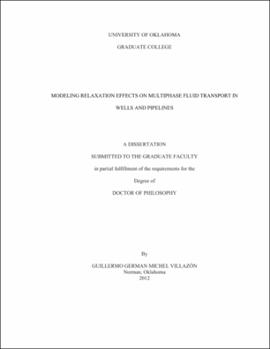| dc.contributor.advisor | Civan, Faruk | |
| dc.creator | Michel Villazon, Guillermo German | |
| dc.date.accessioned | 2019-04-27T21:32:59Z | |
| dc.date.available | 2019-04-27T21:32:59Z | |
| dc.date.issued | 2012 | |
| dc.identifier | 99290368602042 | |
| dc.identifier.uri | https://hdl.handle.net/11244/318975 | |
| dc.description.abstract | The effect of relaxation in processes involving phase transition during flow of reservoir fluids in pipelines and wells is investigated and formulated. Applications concerning the steady-state flow of producing wells, waxy-oil rheology during transient cooling, and wax gelation of shut-in submarine pipes are studied by the means of numerical simulation. | |
| dc.description.abstract | This is accomplished by description of the transport of reservoir fluids flowing through pipes in terms of spatially-averaged phase properties. Several homogeneous models are developed by introducing the spatially-averaged properties into the equations describing the concurrent transport of phases, referred to as multi-fluid model. Thus, the number of unknown variables is decreased from several sets of properties corresponding to each phase in the multi-fluid model to one set of properties corresponding to a single pseudo-phase in the homogenous model. | |
| dc.description.abstract | First, flow of reservoir fluids in oil production wells is described by a three-phase model. Relaxation phenomenon concerning dissolved-gas separation from the oil and water phases is elaborated. Two numerical procedures are presented for simulating the gas/oil/brine flow in production pipes with heat transfer at steady state: one based on liquid holdup estimation and the other based on relaxation of gas separation. Deviation of actual fluid conditions from equilibrium is characterized by a new constitutive equation. Effect of relaxation time and holdup of liquids involving in typical field scenarios is demonstrated for reservoir fluids containing oil, water, and gas phases. It is observed that the liquid holdup phenomenon at steady-state conditions can be described as a metastable state characterized by an incomplete separation of the gas phase. Also, the gas separation from the oil and water phases constitutes two different non-equilibrium processes and, therefore, these phases should not be lumped into one liquid phase. | |
| dc.description.abstract | Second, a description of the more relevant characteristics of crystalline growth for waxy-oils is presented. Relative crystallinity subject to different final temperatures is modeled and correlated for two types of waxy-oils. Laboratory measurements of the rheology for two samples of waxy oil taken at different temperatures are analyzed successfully. Constitutive equations are provided for modeling the viscoelastic behavior, gelation kinetics, and rheology of waxy-oils. The effect of cooling rate on relaxation of waxy-oil gel strength and apparent viscosity is described by three theoretical approaches which relate the relaxed viscoelastic behavior of waxy-oils to their plastic nature based on relaxation in wax crystallization. It is demonstrated by the means of numerical methods that the effect of relaxation phenomenon on wax rheology is significant for cooling rates in the order of units of degrees Rankine per minute. | |
| dc.description.abstract | Third, a modeling of wax solidification in submarine oil pipelines undergoing a cooling process after shut-in is presented. Transport models for transient cooling in a circular pipe cross-section and along vertical pipelines are developed. The wax/oil mixtures are modeled as a multiphase system. A correlation applicable to the fraction of wax precipitated is validated using experimental data. Accurate correlation of pressure dependence of the Wax Appearance Temperature is developed. Relevant mechanisms of wax gelation without forced convection are described in detail. Two finite difference methods are presented for simulating the wax gelation: one applicable over a cross-section without involving force convection and the other applicable to a shut-in submarine pipe. The effects of pressurization and relaxation of wax precipitation on wax gelation are investigated. The simulation results show that the experimental temperature profile of solidifying wax/oil mixture can be explained better by adopting an effective liquid thermal conductivity higher than the actual thermal conductivity. Also, the pressurization effect on solidification of wax is shown to be very significant whereas the effect of relaxation in wax crystallization is negligible. | |
| dc.description.abstract | The information presented in this work may help accomplish effective mitigation of the flow assurance problems in pipelines and wells involving multiphase flow and gelation problems. | |
| dc.format.extent | 202 pages | |
| dc.format.medium | application.pdf | |
| dc.language | en_US | |
| dc.relation.requires | Adobe Acrobat Reader | |
| dc.subject | Multiphase flow | |
| dc.subject | Fluid dynamics | |
| dc.title | MODELING RELAXATION EFFECTS ON MULTIPHASE FLUID TRANSPORT IN WELLS AND PIPELINES | |
| dc.type | text | |
| dc.type | document | |
| dc.thesis.degree | Ph.D. | |
| ou.group | Mewbourne College of Earth and Energy::Mewbourne School of Petroleum and Geological Engineering | |
